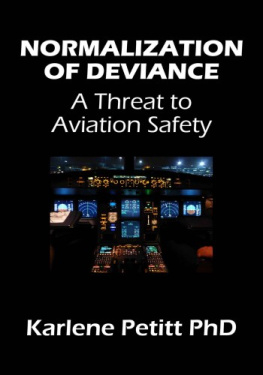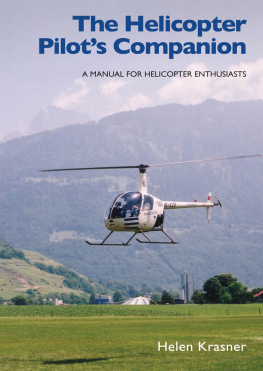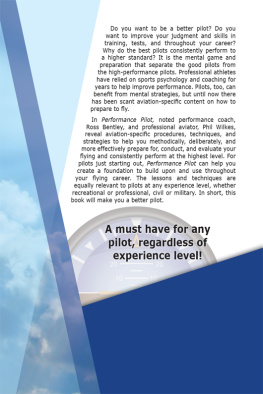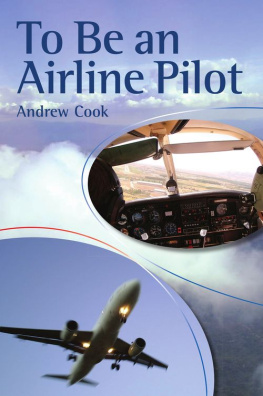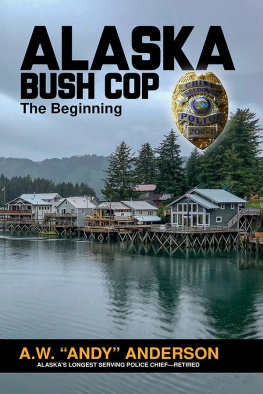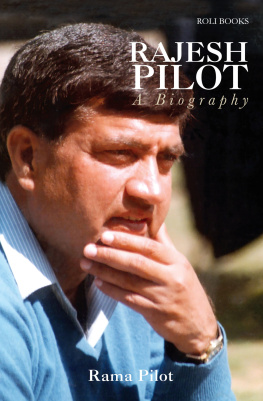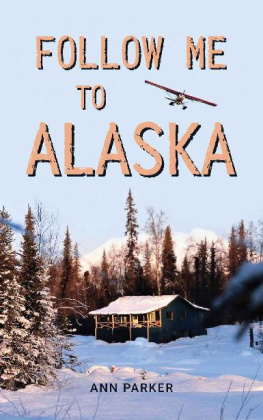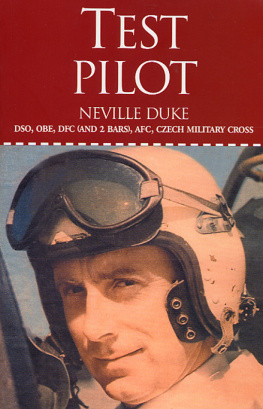BUSH PILOT WAY
Flying and Training in Alaska to Become the Best Pilot You Can Be
William A. (Bill) Quirk, lll

PO Box 221974 Anchorage, Alaska 99522-1974
ISBN 978-1-59433-381-1
eBook ISBN 978-1-59433-382-8
Library of Congress Catalog Card Number: 2013939703
Copyright 2013 William A. (Bill) Quirk, lll
First Edition
Front Cover: The author coming in for a ski landing in the Ruth Amphitheater. Photo by Daryl Pederson.
All rights reserved, including the right of reproduction in any form, or by any mechanical or electronic means including photocopying or recording, or by any information storage or retrieval system, in whole or in part in any form, and in any case not without the written permission of the author and publisher.
Manufactured in the United States of America.
Dedication
T his book is dedicated to the bush pilots of Alaska who have provided a captivating influence in helping fledgling aviators become the best pilots they can be.
Contents
Acknowledgements
I must first honor Chuck Keim, professor in the University of Alaskas Department of Journalism and former dean of the College of Arts and Letters. Although my academic career is in the biological sciences, I veered off track and enrolled in Chucks introductory college course in writing short articles. This was when I was in residence at the university in Fairbanks, Alaska in the early 1970s. Chuck was such an influential teacher that most of his students would go away from that experience knowing that they were capable of writing meaningful narratives. Of course there is no substitute from being a prolific writer to improve your journalistic talents. We were all required to write a short piece to turn in at the end of the semester. I wrote on hunting Mearns quail in Arizona with my clever and multi-talented Weimaraner (Gray Ghost) that could wind, trail, point, and retrieve the birds. I have also benefited in improving my writing skills by being a voracious reader ever since my high school days.
Bill Diehl is a long time aviator that has made significant contributions to aviation in Alaska. Bill recognized the Interstate S-1B1 airplane manufactured by the Interstate Manufacturing Company based in El Segundo, California for its dependable flying characteristics and its durable construction. He believed that it would make a useful bush plane for Alaska. Bill purchased the Type Certificate and tooling from Interstate in the late 1960s and created the Arctic Aircraft Company in Anchorage, Alaska. Arctic Aircraft transformed the Interstate S-1B1 into a bush plane by upgrading structural elements of the fuselage, landing gear, and wings. The redesigned aircraft was designated the Interstate S-1B2 and has come to be known as the Arctic Tern. A Type Certificate for the Arctic Tern was issued by FAA in 1975. Bill produced 31 Arctic Terns in his factory near Anchorage International Airport between 1975 and 1985. Ten additional Arctic Terns were built in the factory by converting Interstate S-1B1s to Terns. Bill also designed and built 4-place Arctic Terns called Privateers. He has built four Privateers.
I am very fortunate to have Marthy Johnson for copy editing the text for the book and Evan Swensen of Publication Consultants for his valuable assistance in preparing the book for publication.
There was nothing that prepared me for the consequences of meeting so many pilots in Alaska. The camaraderie has been fulfilling and it has helped me create a highly inspired learning and flying experience in Alaska. Below is a list of the pilots I have met along my aviation journey in Alaska.
Glen Alsworth, Bret Andersen, Tyler Andrews, Walt Audi, Jim Bailey, Jay Balwin, Thomas Beckman, Gary Bishop, Paul Boots, Bob Breeden, Bill Brown, Glen Burkheimer, Wally Butts, David Calkins, Terry Cartee, Dan Case, Scott Christy, John Claus, Paul Claus, Sam Cole, Bert Crowley, Dick Davidson, Ray Davis, Sean Davis, Tony Dawson, Phil Dean, Dee Deoudes, Eugene Desjarlais, Bill Diehl, Michael Dolan, Vicki Dombe, Darlene Dubay, Jeff Duft, Greg Endsley, Mark Faires, Winthrop Faulkner, Ron Fullerton, Jeff Garness, Damon German, Lars Gleitsmann, Charles Goentzel, Peter Goldberg, Andrew Granger, Bill Granger, Rick Grant, Lee Griffin, Robert Haggerty, Bill Hamm, Chet Harris, Dorothy Harris, Steve Harvey, Gary Hofstrand, Terry Holliday, Dan Hollingsworth, Herb Hubbard, Cliff Hudson, Jay Hudson, Oren Hudson, Ray Huot, Zachary Johnson, Wolfgang Junge, Larry Kaniut, Jo Ann Keller, Matthew Keller, David Krall, Tim LaPorte, Paul Larson, Dr. Scott Laudon, Tom Laughead, Dr. Finn Lunoe, Dr. Leif Lunoe, Clinton MacArthur, Dave Machado, Bob Magnuson, Dr. Michael McNamara, Mike Meekin, Joe Mets, Alfred Meyer, Kris Ogonoski, Joe Pazsint, Perry Pearce, Kellie Peirce, John Peterson, Richard Reiley, James Rood, Bill Roth, Heidi Ruess, Danny A. Sanchez, John Schoen, Ed Sharpe, David Slenkamp, Alex Stanionis, Calvin Stephens, Dick Sutliff, Robin Sylvester, Sean Sylvester, John Thorsness, John Toenes, Randy Tyler, Charles Vandergaw, Robert Vanderpool, Art Warbelow, Charlie Warbelow, Ron Warbelow, Dave Wartinbee, Billy Weidekehr, Adam White, David Wilks, Kenneth Wolter, Paul Woodward, Eric Yould, Patricia Yould, Mike Zaidlicz and Doug Zweifel.
Warning and Disclaimer
T his book provides basic knowledge on flying techniques that bush pilots use in their conventional operations in Alaska. Please note that serious injury or death may occur from attempting to duplicate any of the techniques described in this book. This especially applies to pilots without the proper experience, skill levels, judgment, and common sense. Do not attempt any of the books techniques without weighing the risks to you, your passengers, and your airplane. The author and the publishers of this book are not responsible for any readers negligence, ignorance, or downright stupidity.
The basic theme in this book is self-training. If any techniques discussed in this book are attempted, it becomes the sole responsibility of the pilot to make the decision to proceed with the undertaking. You will be proceeding on your own terms, on your own risk, and with your own assurance that you can perform the task at hand. None of the decisions to train in your aircraft are implied in the book.
Preface
W hy learn to fly the Alaskan Bush Pilot Way? It is the most potent pilot training or for that matter for any learning or training program possible. The Federal Aviation Administration and many others have uncertainties about the training. The training may be open to interpretation, speculation, and condemnation. However, I have found a world-acclaimed educational professor by the name of Sir Ken Robinson who has substantiated the effectiveness of self-training which is the bush pilots way of training. The authors of Super Brain, Deepak Chopra, M.D. and Rudolph E. Tanzi, Ph.D., Harvard Medical School have also shown through a persons increased self-awareness and conscious intention, the brain can be taught to reach far beyond its present limitations.
The most important consideration about training the bush pilot way is to fully understand how the training is conducted. What I mean by this is that self-training is the modus operandi used in bush pilot training. Everything you do as a pilot in your training program is based on this important concept. Read about and discuss flying with other pilots as much as possible; however, in the end, you must take command and develop your own training program. You as the pilot in command will need to fly your own training sessions. You will develop into the best pilot you can be by learning on your own.


